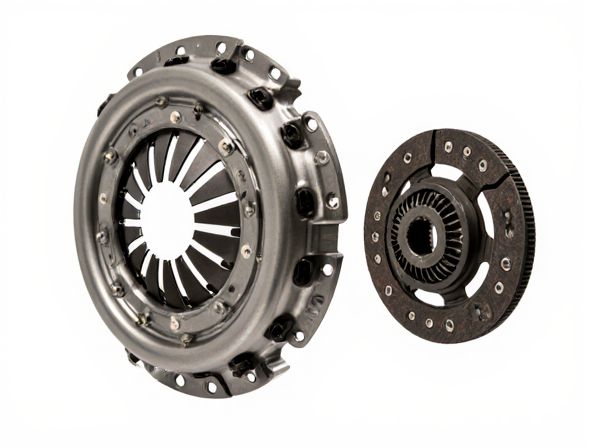
Photo illustration: Centrifugal Clutch vs Diaphragm Clutch
A centrifugal clutch automatically engages based on engine speed, providing smooth acceleration without manual input, making it ideal for small engines and go-karts. A diaphragm clutch, on the other hand, uses a spring diaphragm to engage and disengage, offering precise control and durability commonly found in motorcycles and cars. Understanding the differences helps you choose the best clutch type for your vehicle's performance and maintenance needs.
Table of Comparison
| Feature | Centrifugal Clutch | Diaphragm Clutch |
|---|---|---|
| Operation | Automatically engages based on engine speed using centrifugal force | Manual engagement via diaphragm spring pressure controlled by clutch pedal |
| Common Use | Small engines, scooters, go-karts | Cars, trucks, heavy-duty vehicles |
| Engagement Smoothness | Smoother at low RPM, less slip | Precise control, smooth engagement with pedal modulation |
| Maintenance | Low maintenance, fewer moving parts | Requires periodic adjustment and replacement of diaphragm spring |
| Durability | Less durable under heavy loads | High durability and load capacity |
| Cost | Generally lower cost | Higher cost due to complex design |
| Control | Limited driver control, automatic engagement | Full driver control over clutch engagement |
Introduction to Clutch Mechanisms
Centrifugal clutches engage automatically based on engine speed, utilizing centrifugal force to connect the drive shaft without manual input, making them ideal for applications like go-karts and small motorcycles. Diaphragm clutches rely on a spring-loaded diaphragm plate to engage and disengage the engine from the transmission manually, offering precise control favored in automotive and heavy machinery. Understanding the fundamental differences in actuation and control mechanisms is essential for selecting the appropriate clutch system for specific mechanical needs.
Overview of Centrifugal Clutch
A centrifugal clutch operates by using centrifugal force to engage the clutch plates as engine speed increases, enabling smooth power transmission without manual input. It is commonly found in small engines, go-karts, and chainsaws due to its automatic engagement and simplicity. This clutch type reduces wear and eliminates the need for a clutch pedal, offering efficient performance for low to medium power applications.
Overview of Diaphragm Clutch
Diaphragm clutches use a flexible diaphragm spring to engage and disengage power transmission smoothly, allowing for consistent clutch pressure and improved pedal feel. This design reduces wear on friction surfaces by evenly distributing pressure across the clutch plate, enhancing durability and performance in various vehicle applications. Ideal for high-torque environments, diaphragm clutches offer compact size and reliable operation, making them a preferred choice in modern automotive and industrial machinery.
Key Working Principles Compared
A centrifugal clutch engages automatically through centrifugal force as engine speed increases, using weighted shoes or friction pads that move outward to connect the drive shaft. In contrast, a diaphragm clutch relies on a flexible diaphragm spring to apply pressure on the clutch plate, enabling controlled engagement when the clutch pedal is pressed or released. The centrifugal clutch suits applications with variable speed control, while the diaphragm clutch provides precise manual modulation for smoother gear shifts.
Performance and Efficiency Analysis
Centrifugal clutches offer automatic engagement and smooth power transfer at specific RPMs, enhancing acceleration efficiency in small engines and motorcycles, but may introduce slip under heavy loads. Diaphragm clutches provide more precise control and consistent torque transfer with higher clamping force, improving performance in high-torque applications like automotive transmissions. Efficiency analysis shows centrifugal clutches excel in reducing rider effort and wear in low-power systems, whereas diaphragm clutches optimize durability and responsiveness in demanding driving conditions.
Applications in Automotive and Industry
Centrifugal clutches are widely used in small engine applications such as go-karts, motorcycles, and lawn equipment due to their automatic engagement based on engine speed, providing smooth power transmission without manual control. Diaphragm clutches find extensive use in automotive manual transmissions and industrial machinery where precise clutch engagement and disengagement are critical for controlling torque and protecting drivetrain components. Both clutch types optimize performance in their respective sectors by balancing ease of use, durability, and torque management.
Durability and Maintenance Considerations
Centrifugal clutches offer lower maintenance requirements due to their simple, self-engaging design, which reduces wear under normal operating conditions. Diaphragm clutches, built from a single-piece spring steel disc, provide higher durability for frequent engagement and disengagement cycles but require periodic adjustment and inspection to maintain optimal performance. Choosing between the two depends on the application's demand for longevity versus ease of maintenance in varying operational environments.
Cost Comparison: Centrifugal vs Diaphragm Clutch
Centrifugal clutches generally offer a lower initial cost compared to diaphragm clutches due to simpler design and manufacturing processes. Diaphragm clutches, featuring a more complex mechanism with a single, flexible diaphragm spring, typically incur higher expenses in production and maintenance. Cost efficiency of centrifugal clutches makes them favorable for budget-sensitive applications, while diaphragm clutches provide enhanced performance justifying their premium price in high-precision environments.
Advantages and Disadvantages of Each Type
Centrifugal clutches offer automatic engagement and smooth power transmission at varying engine speeds, reducing manual control but may cause slippage under heavy loads, leading to wear and reduced efficiency. Diaphragm clutches provide precise control and higher torque capacity with a consistent clutch feel, yet they require manual operation and can be more complex to service. Selection depends on application needs, where centrifugal clutches suit small engines and automatic engagement, while diaphragm clutches excel in performance vehicles needing reliable, adjustable clutch engagement.
Choosing the Right Clutch for Your Needs
Choosing the right clutch depends on your application's torque requirements and operational environment; centrifugal clutches excel in automatic engagement and low maintenance for small engines, while diaphragm clutches provide precise control and high torque capacity, ideal for performance vehicles and machinery. Consider durability, ease of installation, and responsiveness--centrifugal clutches engage smoothly at specific RPMs, making them suitable for go-karts and lawn equipment, whereas diaphragm clutches offer consistent pedal feel and improved heat dissipation. Matching clutch type to equipment workload and driving style ensures optimal performance and longevity, reducing wear and enhancing overall system efficiency.
 caratoz.com
caratoz.com